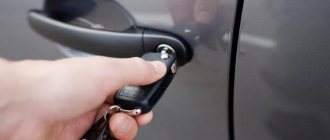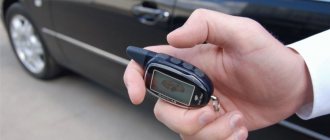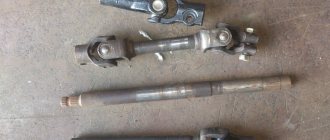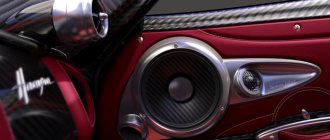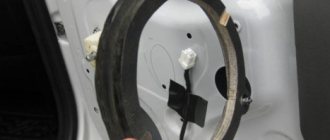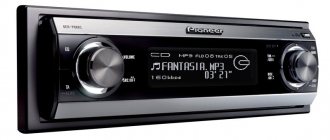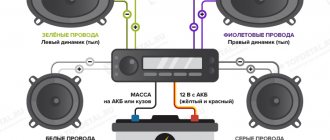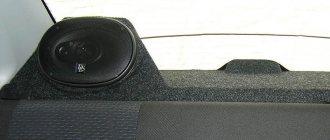Hi all! Agree that the atmosphere in the car interior largely depends on the performance of the audio system, which consists of speakers, a subwoofer, an amplifier and other components. The equipment depends on the specific car. At the same time, situations often arise when the speaker in the car wheezes.
This is an extremely unpleasant phenomenon that can significantly ruin the pleasure of listening to music. Driving in the cabin in silence, or listening to the sound of the engine or wheels touching the road is not particularly pleasant. When there is no interlocutor nearby, the audio system becomes the only way to cheer yourself up and lift your spirits.
Today we’ll talk about what to do in such situations, why they can occur, and how to fix the system yourself. In many respects, you should start from whether only one speaker began to wheeze, or the problem occurs simultaneously on all devices.
Character of wheezing
Most often, owners of low-quality speakers complain about wheezing during work.
In this case, interference occurs only at high volumes. To try to find out the true cause of the defect, it is recommended to determine the nature of wheezing:
- temporary interference - wheezing appears immediately after switching on, and after a while disappears or is constant;
- symmetry - the speakers wheeze together or only one of them;
- dependence on volume - wheezing at high, low or when adjusted;
- the presence of wheezing if there is a telephone near the speakers.
You should also pay attention to the technology used to play audio files. Perhaps the reason is not in the speakers. So, if the connected speakers wheeze on the music center, but not on the computer, then problems arise precisely on the first audio equipment.
Important point! If new speakers begin to wheeze, you can send them for free diagnostics by contacting the seller.
Inadequate car radio setup
This most often occurs when car speakers choke all over the place and at high volumes.
To eliminate this cause, pay attention to the equalizer settings. Perhaps the low frequencies are inverted and the power of the radio is not enough to “feed” them
In BASS, SUPER BASS, ROCK modes, low frequencies are by definition overestimated.
Also, many models have a forced sound amplification setting. Denoted as LOAD. In general, if you use this function wisely, the sound quality of the acoustics of cheap cars can be radically changed for the better. On the other hand, when turned on at high volume, the speakers begin to hiss.
Causes and signs of sound distortion
So, why does hissing appear in car speakers and how to deal with it? If the problem appears immediately after installing new speakers, this indicates that the power of the radio amplifier is greater than that of the speakers. The average power level of a car radio is about 45-55 W.
Troubleshooting first comes down to correctly understanding what the problem is:
- noise appears only in one speaker;
- wheezing is observed in all speakers;
- the problem appeared suddenly;
- the noise was quiet at first, but over time it began to increase;
- wheezing is heard only at minimum volume;
- The car speakers wheeze at the highest volume.
Acoustics Pioneer for the car
As practice shows, speakers usually wheeze when listening to audio at full volume. This is usually due to dust and moisture getting on the speaker. But let's look at all the defects in order.
One speaker
If the problem appears with only one speaker, then the problem may lie either in it, or in the radio itself, or in the connected wiring. The amplification device consists of several independent amplifiers, so the problem can really only affect one element. Diagnostics in this case comes down to connecting a speaker that is known to work instead of the one that hisses. If the defect remains, then the cause should be sought either in the wiring or in the audio system itself.
It happens that damage occurs during the installation of wiring or an audio system on a car. Minor damage can cause corrosion and loss of contact. Accordingly, this leads to distortions in the future. If the cause of the defect lies in the column itself, then you just need to replace it with a new one.
Car speaker disassembly
All at once
If the defect appears on all elements of the audio system at once, then it is unlikely that you will need to repair all the speakers at once, but this is quite possible. In particular, if the driver listens to loud music at high power for a long time. This can cause the coils to overheat, causing them to simply fall off the frame. If the malfunction manifests itself abruptly, then repairing the speakers is unlikely to help, since the reason in this case usually lies in the car radio or amplifier itself.
When purchasing an audio system for your car, you need to be careful not to purchase a low-quality installation. When purchasing, be sure to pay attention to the body of the speakers themselves - they are marked with maximum power, which can be maintained for a short time. As a rule, this figure is 300-350 W. In fact, the real power will be significantly less than the power of the amplifier in the radio.
At the same time, this defect may appear on all elements as a result of insufficient voltage level in the on-board network. It is possible to identify such a problem. If, when the volume is increased, the radio display starts to go dark or blink, this indicates a voltage problem. As an option, you can diagnose the wiring contacts (the author of the video is AVTO CLASS).
Distortion appears at minimum volume
Speaker repair may also be required if distortion occurs at minimum volume. Before you repair a car speaker, you need to pay attention to diagnosing the wiring that goes from the terminals to the coil itself. In practice, flexible wires often break off at the soldering point. It is quite possible to determine the defect yourself - usually when you touch the wires, the hissing disappears.
Do-it-yourself speaker repair in this case comes down to removing the broken part and soldering. You can also try to solve the problem by soldering the wiring to the high-frequency speakers from below. In this case, it will be possible to connect the wiring so that it does not move, but the only drawback will be that it will be visible.
Distortion at maximum volume
There may be several reasons for distortion at high volumes:
- audio systems;
- car radio power supply;
- acoustics.
You can try to repair the speaker if it is the only one wheezing. If distortion occurs in all speakers, this may be due to exposure to moisture, as a result of which the diffuser may break and the suspension will lose its elasticity, in particular if this element is made of paper. In addition, dust that gets under the coil through the cap can cause a problem. And, of course, a repaired speaker will never play normally if there are voltage problems in the network. In addition, one should take into account such a nuance as the old age of the speaker system.
Correspondence between speaker and amplifier power
It is worth noting that the average car radio produces 45-55 W of power. Car speakers have a power rating of about 20-40 watts or more. As a rule, manufacturers prefer to indicate the peak power of speakers or RMS watts on boxes and in product cards. To obtain the real value, the declared value must be divided by approximately 10. That is, typical 300-watt speakers actually produce about 30 W of nominal volume. All this applies to household computer speakers.
Diagnostics
Each defect has its own symptoms and signs. Knowing the main problems, you can decide in which direction to look for the cause. Most often, the following problems occur:
Below we will look at how to eliminate these defects.
Why do the speakers wheeze?
The main reasons for noise and wheezing in a car audio system are high humidity, dirt, overloading of speakers when listening to music at maximum volume, and lack of power. Each of these reasons is unique, may have different external manifestations, and breakdowns are eliminated in different ways.
Connection problems
The most common problem is not even the incorrect connection of the speakers to the sound source (in this case, they would not work at all), but the malfunction of the cables used for this. Electrical wires are very fragile, especially at the junctions with plugs - they are often bent, chafed and damaged, which is why various interference can occur. The reason for this is poor contact, which occurs when the wiring is damaged, between the sound card of a computer, TV or other sound source and the speakers themselves.
Speaker plug
In detail the reasons look like this:
- When cable insulation is damaged, individual wires act on each other, preventing channels from being transmitted individually. In the case of headphones, this situation is most common - one channel simply stops working, as a result of which one ear simply becomes silent or begins to sound intermittently, which disappears if the plug is moved in a certain way. The same situation can be observed with speakers. To fix this, you will need a soldering iron and a sharp utility knife. Use a knife to open the polymer edging of the plug, and use a soldering iron to repair the wiring. However, it is much easier to buy a new plug and screw it to a piece of speaker cable.
- Poor contact may occur between the plug and the socket on the sound card. To fix this problem, most often it is enough to unplug the speakers and plug them back in, or simply move and twist the plug in the socket.
- The cable is poorly secured and dangles in the socket. To fix it, just tape the cable to a table, floor or wall using tape or tape.
Interference can also occur due to signal loss in a cable that is too long. If your speakers are located too far from the sound source, then changing the length of the connection may well get rid of most of the extraneous sounds.
However, before you get into the cables, it’s worth checking the functionality of the speakers themselves. To do this, they should be connected to another sound source.
Errors when installing drivers
The driver - software that controls the sound card of the sound source - is a very important part of any speaker system, the incorrect handling of which can lead to a wide range of problems. If there are no drivers at all, the speakers simply won't work. If errors were made during installation - for example, an outdated version of the program was installed or even a driver for a different sound card model - various problems may be observed in the operation of the speakers, including extraneous sounds.
Most often, such problems appear immediately after reinstalling or automatically updating Windows. Although drivers can also be damaged by third-party programs - for example, viruses, some of which delete the original driver files and disguise themselves as them in order to silently perform their malicious functions.
Sound devices in Windows Device Manager
You can find out if everything is ok with your sound drivers using standard Windows tools. You should use the device manager, which will clearly show all existing problems, marking non-working devices with a special icon. You can access this utility either through managing my computer or through the control panel. When the manager window opens (this may take some time - the computer diagnoses the hardware of the system unit), we need to find the item we are interested in - sound - in the list of all components. By right-clicking on the device you are using and going to the Properties tab, you will see the status of your sound card.
If problems are found, the drivers need to be updated. This can be done either automatically or by downloading the required version of the software from the sound card manufacturer’s website. Finding out which driver is needed is very simple - if this was not indicated in the already mentioned device manager, you will have to use one of the third-party software options.
The AIDA64 program, which has a fairly long trial period, is ideal. Having entered it, you need to go to the “Computer” menu and display general information about your computer or laptop. Among all the data received, find the “Sound” column and determine the manufacturer and model of the sound card. Most likely, you will have to download the driver from the Realtek website, and the driver itself will be software that controls modern HD Audio technology.
Sound options
Despite the simplicity of standard sound output settings, even the slightest inaccuracies in them can lead to a variety of problems with the operation of the speakers. The most common causes of extraneous sounds are switched on effects or a line input, especially if it is not used for its intended purpose and unnecessarily affects its neighbors on the chip.
Sound settings are opened through the control panel. In these settings, you need to select the device you are using - speakers or built-in laptop speakers - and click on the “Properties” button. A wide menu will open with a variety of adjustable parameters, of which we are interested in exactly one – levels. You need to experiment a little with them until the speakers come back to normal. Don’t be afraid to ruin something - everything can be returned as it was if necessary.
Volume of input and output channels in Windows
Speaker quality and sound power
Cheap speakers use low-quality parts that are not capable of performing acceptably at maximum power. As a result, if the speaker volume control is turned up to the maximum, and sometimes even to a certain part of this value, the speakers begin to “choke,” which leads to various creaks and groans from the speakers. This situation happens quite often - the user turns here and there, and as a result the wheel on the speaker ends up in the extreme position, and the volume slider in the system on the computer is at 1-2%. To return the sound to the proper quality, the hardware volume should be returned to the working zone - no further than the first third of the turn of the control.
Exposure to electric current
Laptop speakers may experience problems due to the power consumption mode being too economical. The speakers lack power, which is why they begin to wheeze. To return everything to normal, you need to select the maximum performance mode in the laptop's energy saving settings.
Another point is grounding. A current constantly flows through the speakers, which can be useful - it makes the device work, but quite useless - it prevents the speakers from producing clear sound. To get rid of this effect, you need to connect the speaker body to a radiator or heater with a piece of copper wire. Along it, excess energy will move away from dynamic emitters.
Factory defect, breakdown of column parts
It should be noted that there is another common source of problems with audio signal output - malfunctions of the speaker hardware. You can read more about these problems in this article.
Cracking, hissing, wheezing sound on the laptop: what to do to fix the problem
Work and entertainment on a computer cannot be considered complete if there is no sound on it. It is necessary to watch movies, listen to music, receive notifications of new messages, and so on. You can name hundreds of programs, sites, games and applications that lose their relevance without sound.
The sound should be clear and loud, and its distortion is a big problem that every Windows 10 user may encounter. If the sound on your computer begins to crackle, wheeze, sound muffled, hiss, or has other problems with it, you need to fix the problem as soon as possible malfunction. In this article, we will look at the main reasons why similar sound problems can occur in Windows 10, as well as ways to fix them.
How to identify wheezing car speakers
Sound distortion in the form of unpleasant wheezing can appear both in all speakers in the cabin, and in just one of them. At the first stage of troubleshooting, it is extremely important to establish this. There are several ways to do this. Let's look at the two most understandable and simple ones.
The first method is to mute the speakers one by one using the car radio settings menu. Even in cheap Chinese options, this feature is usually provided. It is implemented in the form of balance and fader adjustment. Referred to as the BAL and FAD settings, respectively.
Balance is an adjustment of the car radio that allows you to distribute the power of the amplifier built into it between all the right and left speakers. That is, if you twist (press) BAL in one direction or the other, you can completely muffle all the sound from one side of the cabin. For example, if you turned the balance completely to the right or left, and the wheezing of the speakers disappeared, then it now becomes clear whether it is on the left or right relative to the interior.
However, this is still not enough. With the help of balance, you can only determine the side of the speaker that is causing distortion. However, on the one hand there are at least two of them. To figure out whether the front or rear is wheezing, adjusting the fader (FAD) can help. This adjustment redistributes the car radio's output power between the front and rear speakers.
Example. Let's say that after adjusting the balance, it turned out that the wheezing disappeared when all the power was shifted to the right side. In this case, you now need to reconfigure the balance completely to the left. The wheezing will return. Next, using the fader settings, you need to alternately direct all the power to the front left and rear left speakers.
After playing with just these car radio settings, you will definitely figure out the speaker that is wheezing. But only if there are only four of them in the cabin. If there are two or more speakers on any of the four channels, this complicates the situation. And you can get out of it by using the second diagnostic method.
It consists in alternately physically disconnecting the dynamic heads from the signal wires. In this case, you will have to disconnect not from the car radio, but directly from the speakers themselves. The task is to find a speaker, after which, when turned off, the wheezing will disappear. This method, by the way, will help if the radio does not have the settings described above (as a rule, balance adjustment is available on all models, but FAD is not always available).
The next step is to understand at what volume level a wheezing speaker wheezes. Distortion can occur both at maximum volume and at minimum volume. In the process of calculating a faulty speaker, it is very desirable to establish this point. This will be useful for further diagnosis.
Debris getting into magnetic gaps
This problem is more common with speakers with a coaxial design. These speakers are the most common. It remains to check whether the debris caught in the magnetic gap is the cause of the appearance of extraneous sounds. To do this, you need to gently press the diffuser with your fingers. If there is a feeling of mechanical resistance while moving, then debris is present.
It can be located between the diffuser and the tweeter stand. Over time, the debris falls into the magnetic gap, where it begins to rub against the coil. If it is not magnetic or metallic, then you can try to shake it out. You can turn the speakers over, turn on the music, listen for a while, they will work. Due to gravity and vibration, debris will leave the speakers.
Preventive measures to reduce the likelihood of wheezing in the columns
- do not overload the amplifier and speakers, do not set the level controls to maximum values;
- Make sure that moisture and dust do not get into the speaker systems;
- when installing additional PAs and non-standard speakers, ensure that the output and input parameters of the audio system match, and be sure to install isolation filters;
- secure the speakers and speakers to the body well, check the fastenings periodically, as they may become loose as the vehicle moves over rough terrain as a result of shaking.
Video - if the speaker in the car wheezes, how can you fix it without disassembling it:
Phone drops
The second reason why the speaker on your phone wheezes is when the device falls. In general, any fall for a phone, one way or another, has negative consequences, but in this case we are talking about dynamics. The fact is that if you fall, there is a high risk that the contact of the speaker cable may come off due to the impact, or the speaker itself may come unstuck. As a result, when listening to, for example, music, extraneous noises, crackling noises, etc. will be clearly audible. This, in fact, is why the speaker on the phone wheezes.
What to do in this situation and how can you fix the problem? Here again there are 2 options.
The first is to disassemble the phone yourself, check the contact on the speaker cable, or fix it if it has become unstuck.
The second option is to take the phone to a service center, where a technician will disassemble it and perform all the necessary manipulations.
What is better to choose is up to you.
